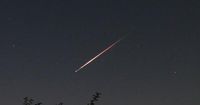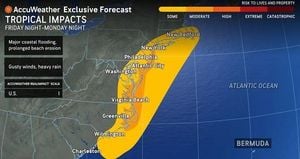Britain’s seas have rarely been so lively—or so warm. According to BBC analysis, from January through the end of July 2025, the average sea temperature around the UK was more than 0.2°C higher than any year since 1980. That might not sound like much, but for marine life, it’s a seismic shift. The result? An influx of new and rarely seen species, including bluefin tuna and salps—those glowing, jellyfish-like marine animals that dazzle underwater photographers and scientists alike. Heather Hamilton’s striking images of these creatures off Cornwall have captivated both the public and marine biologists, highlighting the changing face of British waters.
Why the sudden change? Scientists point to record warm seas, a phenomenon linked directly to broader global warming trends. As Mark Poynting and Justin Rowlatt reported for BBC, these temperature spikes are not just statistical blips—they’re signs of a shifting climate. Salps, which usually prefer warmer, more southerly waters, have rarely been spotted in the UK before. Their arrival, alongside bluefin tuna, signals that the marine ecosystem is experiencing rapid, perhaps unprecedented, transformation.
But Britain’s seas aren’t the only environment feeling the heat. Across southern Europe, the summer of 2025 has been marked by relentless, scorching heatwaves. Temperatures soared above 40°C (104°F) in Spain, Portugal, France, and Italy, forcing thousands to evacuate as wildfires ripped through parched landscapes. Rachel Hagan and Ruth Comerford, writing for BBC, detailed how these blazes have devastated communities and natural habitats alike. Scientists warn that the Mediterranean’s fire seasons are getting longer and more intense. Since the 1980s, Europe’s average temperatures have increased at twice the rate of the global average—a sobering statistic that underscores the urgency of climate action.
While the land and sea are undergoing dramatic changes, the skies have offered their own spectacle. The Perseid meteor shower, one of the year’s most anticipated celestial events, reached its peak earlier this week across much of the northern hemisphere. Caused by dust particles from the comet Swift-Tuttle burning up in Earth’s atmosphere, the Perseids are famous for their bright, fast-moving meteors—sometimes called “shooting stars.” Maddie Molloy, reporting for BBC, explained that Swift-Tuttle is no interloper; it’s a regular visitor, orbiting the Sun every 133 years.
But this year’s Perseids have been especially rewarding for skywatchers. As noted by The Night Sky, the meteor shower remains active into the weekend and next week, with better viewing conditions thanks to a less bright Moon. After midnight, looking northeast, observers have been treated to a cascade of meteors, including the occasional fireball—a much brighter, more dramatic meteor that outshines its peers. Amateur and professional astronomers alike have been encouraged to send in their astrophotography, capturing the fleeting beauty of the event.
And there’s more for early risers. On the morning of August 20, 2025, a thin crescent Moon will appear near Venus and Jupiter above the east-northeast horizon, forming a picturesque celestial trio. The following morning, August 21, the Moon will be positioned just above Mercury, with Venus and Jupiter still close by—a rare and beautiful sight for anyone willing to wake up before dawn.
Not all visitors to our skies are so familiar. In a remarkable astronomical achievement, a team of scientists using NASA’s Hubble Space Telescope captured the sharpest-ever photo of comet 3I/Atlas, only the third known interstellar visitor to our Solar System. According to NASA estimates, this comet was barreling through space at a staggering 130,000 miles (209,000 kilometers) per hour—the highest velocity ever recorded for such an object. “No one knows where the comet came from. It’s like glimpsing a rifle bullet for a thousandth of a second,” said David Jewitt, an astronomer at the University of California, Los Angeles, and the science team leader for the Hubble observations, in a statement quoted by BBC.
Back on Earth, scientists are also unraveling mysteries much closer to home. Every ten years, British Columbia in Canada witnesses a peculiar natural phenomenon: swarms of hairy, orange-black Western tent caterpillars that appear in vast numbers and then vanish as suddenly as they arrived. Judith Myers, a professor at the University of British Columbia, has devoted five decades to studying these fuzzy insects. Her latest research concludes that a virus specific to the caterpillars is the key driver behind their boom-and-bust population cycles. Even more surprising, Myers found that these caterpillars are remarkably resistant to the effects of climate change—a rare bit of good news in an otherwise challenging environmental landscape.
Meanwhile, the race to the Moon is heating up—not just in the sky, but in the halls of space agencies. China has completed successful tests of its “Lanyue” ascent vehicle, designed to place astronauts on the lunar surface by 2030. This comes at a time when NASA’s own lunar ambitions are facing headwinds, with budget cuts and logistical hurdles threatening to delay American plans to return to the Moon. As reported by The Night Sky, China’s progress may provide the nudge NASA and its partner SpaceX need to accelerate their own efforts.
The world of space exploration also paused to remember a legend: Commander Jim Lovell, famed Apollo 13 astronaut, who passed away at the age of 97 in August 2025. Lovell’s calm leadership during the harrowing Apollo 13 mission, immortalized in both history and Hollywood, earned him a permanent place in the annals of spaceflight. As The Night Sky noted, Lovell once reflected, “Only when he and his crew had returned safely to Earth, did he realize he didn’t get to walk on the Moon.” Yet his actions under pressure spoke volumes about his character. Lovell also shared a moment of perspective, recalling how, from space, he could blot out the entire Earth with his thumb and contemplate the billions of lives behind it—a reminder of our shared humanity and the fragility of our planet.
In other astronaut news, Barry “Butch” Wilmore, who spent an unexpectedly extended stint aboard the International Space Station alongside Suni Williams, has retired from NASA duties. Wilmore’s resilience and adaptability during his time in orbit have been widely praised, marking the end of an era for one of NASA’s most experienced spacemen.
From the depths of Britain’s warming seas to the fiery forests of southern Europe, from the dazzling meteor showers above to the relentless quest for the Moon, the summer of 2025 has been a season of striking contrasts and scientific wonders. As the world continues to change, both in ways we can see and those we can only imagine, one thing is certain: curiosity and discovery remain at the heart of the human story.




